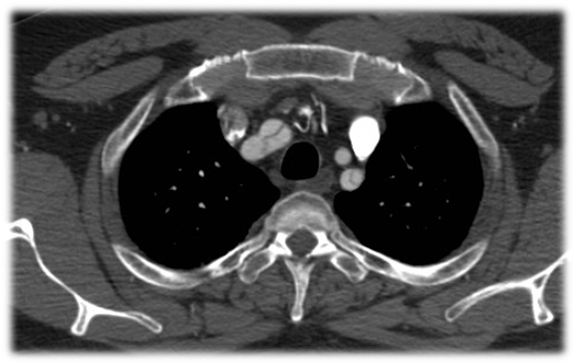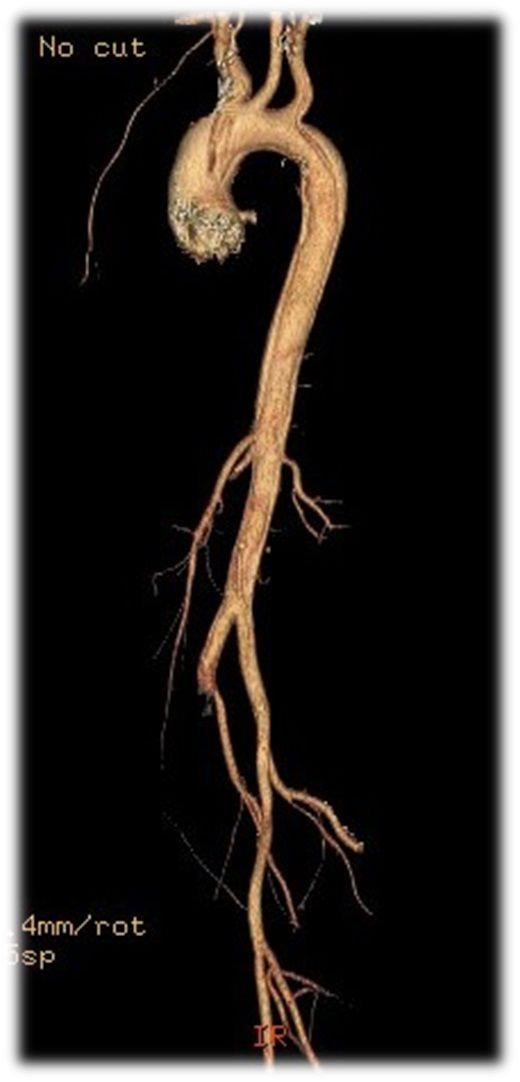Silent Non-traumatic Extensive Aortic Dissection
A 40-year-old male presented at the ER with chest discomfort and tacchypnia. No abnormal radiological findings could be detected on the chest X-ray. On examination ischemic changes on the right lower limb, with ECG changes were noted.
Clinical history: A 40-year-old male presented at the ER with chest discomfort and tacchypnia. No abnormal radiological findings could be detected on the X-ray examination of the chest. On examination ischemic changes on the right lower limb, with ECG changes were noted. Post IV contrast CT aortic angiography revealed extensive dissection involving the aortic root, ascending, arch, descending segments of the aorta, with involvement of the left subclavian, brachiocepahilic, common iliac arteries . Thrombosed right external iliac and superficial femoral arteries are also seen.

Figure 1: CT aortic angiography in axial section, demonstrates the presence of hypodense dissecting intimal flap at the aortic root and descending thoracic aorta ( Stanford type A).

Figure 2: Contrast-enhanced CT aortic angiography in axial section, demonstrates Stanford type A aortic dissection with intimointimal intussusceptions in the aortic arch.

Figure 3: Contrast-enhanced CT aortic angiography in axial section, demonstrates hypodense dissecting intimal flap at both common iliac arteries.

Figure 4: Contrast-enhanced CT aortic angiography in axial section, demonstrates failure of contrast enhancement of the right external iliac artery due to occluded lumen by thrombus formation.

Figure 5: Contrast-enhanced CT aortic angiography in axial section, demonstrates failure of contrast enhancement of the right femoral artery due to luminal occlusion by thrombus formation.


Figures 6a and 6b: Contrast-enhanced axial and coronal CT aortic angiography in axial section, demonstrates hypodense intimal flap involving the left subclavian, and right innominate arteries

Figure 7: Reformatted volume rendering CT image, demonstrates extensive dissecting intimal flap involving the root, ascending, arch, descending aortic segments as well as the common iliac arteries with thrombosed right external iliac artery.
Diagnosis: Silent non-traumatic extensive aortic dissection
Discussion: Acute thoracic aortic dissection is a cardiovascular emergency being a life-threatening condition that requires immediate prompt diagnosis and treatment.
Multislice CT angiography allows diagnosis of acute aortic dissection with a sensitivity and specificity of nearly 100 percent. Dissection is classified according to the extent of involvement of the thoracic aorta. The original system for classification of aortic dissection, the DeBakey system, has been superseded by the Stanford system. Dissection affecting the ascending aorta or the aortic arch is classified as Stanford type A (DeBakey types I and II) and accounts for 75 percent of cases of aortic dissection.
Thoracic aortic dissection may be described as acute or chronic, depending on its clinical manifestation. Dissection is considered acute if the symptoms last less than two weeks and chronic if they last longer. Seventy-five percent of deaths from the condition occur within two weeks after the initial manifestation of symptoms.
Patients affected by Stanford type B dissection is treated medically for hypertension unless complications occur (e.g., abdominal organ ischemia or persistent pain) that indicate a progression of the dissection and, eventually, the need for surgery.
Typical aortic dissection is produced by an intimal tear that allows blood to enter the medial layer, giving rise to two lumina, one true and one false. Although hypertension is the most frequent factor predisposing patients to aortic dissection, other conditions also are associated with dissection, including Marfan syndrome and Turner syndrome, other connective tissue diseases, congenital aortic valvular defects, aortic coarctation, aortic aneurysm, infection and other causes of aortitis, and pregnancy.
The main finding on contrast-enhanced CT scans of aortic dissection is an intimal flap that separates the true lumen from the false lumen. Accurate differentiation at CT between the true and the false lumen recently has become particularly important for planning endovascular treatment of dissection.
Important signs that indicate the false lumen include a larger cross-sectional area, the cobweb sign and the beak sign. The cobweb sign appears as slender linear areas of low attenu¬ation specific to the false lumen due to residual ribbons of media that have incompletely sheared away during the dissection process. On the other hand, the beak sign seen at cross-sectional imaging as a wedge of hematoma that creates a space for the propagation of the false lumen.
Intimo-intimal intussusception is an unusual type of aortic dissection produced by circumferential dissection of the intimal layer, which subsequently invaginates like a windsock.
Death from thoracic aortic dissection is usually caused by acute aortic regurgitation, major branch-vessel obstruction, pericardial tamponade, or aortic rupture, causing blood to leak into the surrounding structures. Such events are usually fatal.
Cerebral ischemia associated with aortic dissection is caused by supra-aortic trunk involvement, occurring in only 5 percent to 10 percent of patients with aortic dissection.
Ibrahim Eldesouky, MBBCh, MSc., MD, consultant radiologist and assistant professor, radiodiagnosis, Ministry of Scientific Research, Cairo, Egypt
What New Research Reveals About Novice Use of AI-Guided Cardiac Ultrasound
April 4th 2025In a study recently presented at the American College of Cardiology (ACC) conference, researchers found that novice use of AI-guided cardiac ultrasound after an AI-enabled electrocardiogram increased the positive predictive value for reduced left ventricular ejection fraction (LVEF) or aortic valve stenosis by 33 percent.
The Reading Room Podcast: Current Perspectives on the Updated Appropriate Use Criteria for Brain PET
March 18th 2025In a new podcast, Satoshi Minoshima, M.D., Ph.D., and James Williams, Ph.D., share their insights on the recently updated appropriate use criteria for amyloid PET and tau PET in patients with mild cognitive impairment.
Study with CT Data Suggests Women with PE Have More Than Triple the One-Year Mortality Rate than Men
April 3rd 2025After a multivariable assessment including age and comorbidities, women with pulmonary embolism (PE) had a 48 percent higher risk of one-year mortality than men with PE, according to a new study involving over 33,000 patients.
GE HealthCare Debuts AI-Powered Cardiac CT Device at ACC Conference
April 1st 2025Featuring enhanced low-dose image quality with motion-free images, the Revolution Vibe CT system reportedly facilitates improved diagnostic clarity for patients with conditions ranging from in-stent restenosis to atrial fibrillation.